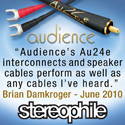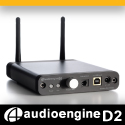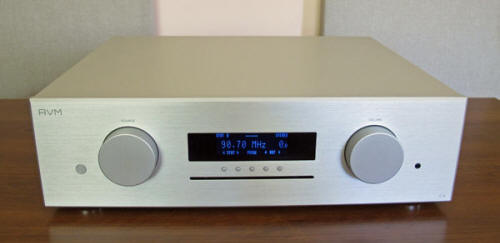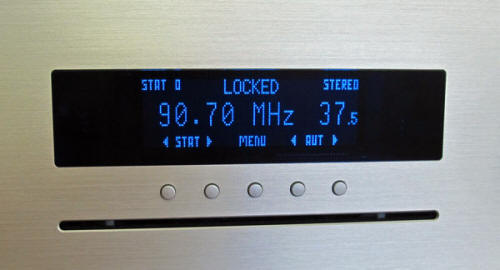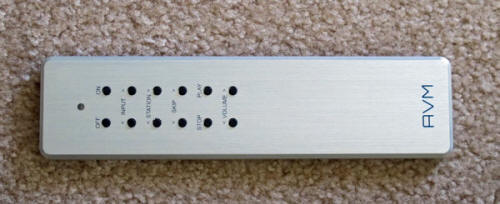|
|
You are reading the older HTML site
Positive Feedback ISSUE 61
avm audio C9 CD Receiver as reviewed by Kent Johnson
In the late 1970s, I was a subscriber to Rolling Stone magazine. I came home one afternoon to find the new issue in the mailbox so I sat down to browse through it. There was a full-page ad several pages inside for a sweepstakes being run by RS, which featured a Sansui G-9000 receiver as first prize. That got my attention. More motivational was the fact that the first 100 entries received a free t-shirt! I filled out the form, cut it out, sent it back the next day, and then pretty much forgot about it. About six weeks later, I came home to find a message on my answering machine from Jann Wenner, the editor of Rolling Stone. His message informed me that I had won the Sansui receiver. I was truly stunned and had to play the message several times to make sure that I understood it correctly. It was too late in the day to call the New York number he had left but I got on the phone the next morning and made all the necessary arrangements to get the G-9000 shipped. It took about a month for the receiver to arrive. If you can remember how time stood still between Thanksgiving and Christmas when you were eight years old, you know precisely how the time dragged for me. The G-9000 did arrive and it was huge and gorgeous. I believe it was rated at 160 Watts into 8 Ohms and had every available switch, knob, and control known to audiodom on its front panel, not to mention power meters. At the time, it retailed for $1000 making it worth at least three times the value of the entire system that I was then using. I don't think that I have ever experienced greater pride in any piece of audio equipment that I have owned. I managed to upgrade my system with a pair of Electro Voice Interface A speakers over the next few months but that was as far as I got before losing the Sansui and the rest of my equipment in my divorce. I got the china. Over the years, I have wondered just how good the G-9000 might actually have sounded had I been able to build any sort of system around it from comparable quality components. I have had several older Sansui 9090 receivers pass through my hands over the past few years and listening with my Sony XA5400 player as the front end, DH Labs Revelation cables, and Quad 21L2 speakers, the sound was surprisingly good. This, despite the limitations imposed by the stock speaker terminals which only accept 16 gauge wire. In theory, the G-9000, the 9090's successor, should have been even better. These big, powerful, heavy Japanese receivers have enjoyed something of a renaissance as listeners of my age revisit the equipment that they could never afford when they had the hearing to enjoy it. I wouldn't mind hearing a G-9000 again just to satisfy my curiosity. Beyond that, I really have no desire to own one. I may be becoming a vintage person but I am not really a vintage audio enthusiast. The receiver is still with us today although mainly as a home theater component. Audio-only receivers are few and are generally viewed as entry-level equipment too compromised to be considered as high end components. What if, though, someone designed and built a completely modern receiver as a no-compromise audiophile component? What would it be like? Well, the people at Audio Video Manufaktur GmbH of Malsch, Germany have done it. It is called the AVM Evolution C9 CD Receiver. In addition to providing the traditional receiver complement of FM tuner, preamp (with both moving magnet and moving coil phono capabilities), and amplifier, the AVM C9 also includes a CD player, an externally accessible DAC, iPod compatibility, and a wide variety of connection capabilities. All of this is presented in an impressively attractive package which costs $5750. But wait, there's more! An internal wireless streaming module is just becoming available. It will be user-installable and will cost $450. I suppose that there may be some listener who would also like a built in cassette deck but otherwise it is difficult to imagine anyone whose audio needs can't be fully served by an AVM C9. Description The AVM C9 looks like it is machined from a solid billet of aluminum so precisely fitted are the panels that fashion its case. The top and side panels are actually 4mm thick aluminum while the fascia is 10mm thick—substantial and solid but not excessive. It measures 17 inches wide by 15 inches deep (including knobs and speaker posts), and is 5 inches tall. It is when you pick it up and discover that it weighs considerably less than you expect it to (about 17 pounds) that its use of Class D amplification becomes apparent. Rated at 180 Watts per Channel into 8 Ohms and 300 WPC into a 4 Ohm load, any other form of amplification would be impracticably large and hot for such a compact chassis. Contrasting with the tremendous power potential of the amplifier is the C9's electrical draw at standby—less than 1 Watt. Spend some time with the Evolution C9 and you quickly realize just how clever the Germans who have designed and built this component truly are. And logical. I did not get a manual with the C9 nor is it available on the AVM website. Still, I was able to figure out virtually everything easily on my own. The layout and organization of the controls make obvious sense. And come in stark contrast to the stupidity with which the people making computers, cell phones, GPS units, etc. organize controls and functions. (Vintage person speaking here.) The front fascia has a small, nearly invisible, Stand-by switch at the far left next to the large Input Selector knob. The large knob to the far right is the Volume Control, which has a range from 0 to 99.5dB in .5dB increments. This sort of accuracy is delightful to experience, since it makes setting the volume utterly precisely—and being able to repeat it—possible. There is more clever stuff in the middle. The very comprehensive white on blue display measures about five by one-and-one-quarter inches. Text is large enough that I was able to read the central portion of the display from my listening position in the living room about eight feet from the C9. This display can be dimmed or turned off. This center section of the display includes the volume level, CD track number, selected input, FM station information, and other necessary data. Lesser information at the top and bottom of the display requires being in front of the C9 to read; this is information that you would be unlikely to need while actually listening.
Below the display are five small buttons and this is where the C9 gets interesting. Depending upon the input selected, the functions of these buttons change and are labeled in the lowest line of the display. When listening to CD, these five buttons become Track reverse, Track forward, Menu (which is always on the display), Stop/Eject, and Pause. When listening to CD, Menu also provides access to Repeat functions (one track, all tracks, or off). When FM is selected the two left buttons scroll through the station presets, the right pair offer Seek/Tuning capabilities. When Phono, the Digital Inputs, or the Auxiliary Inputs are active, only Menu appears on the screen. No matter what input is selected, Menu always provides access to Speaker Selection (there are two sets of outputs), Balance, Tone Control (which is actually a Parametric equalizer), and the Processor loop. I was not able to figure out how to get to menus that allow re-naming or changing the sensitivity of the inputs but they were the only items that I would have needed help to use. The top line of the Display notes any menu selections that are in effect, such as Repeat when playing CDs. Labels for the major information located in the middle of the display, such as the volume level, are also provided. I was not able to try every function available on the C9 but, unlike many components, it appears that you can run/access every function on it without actually needing the remote control. I think this is a very good thing.
The same multi-tasking design carries over to the C9's remote. The all-metal remote has only twelve buttons. Eliminate On and Off and there are ten buttons available to control the entire receiver. This actually works out fine. The remote's buttons also perform different functions depending upon the input selected. This is all done so intuitively that I found myself thinking about the fact that I didn't have to think about what I was doing. I pressed a button; if the immediate result wasn't what I wanted, a second try always got it. The remote measures about 7 inches long by 1.25 inches wide. It is less than half an inch thick. The remote's size and minimal button count make for a nice fit in your hand—volume controls are, logically, right at the bottom where you expect them—but do surrender some capabilities as a result. You cannot directly select tracks by number; you have to move track to track with the forward or reverse button. There is no Mute capability but when the Volume control is held down, the volume level goes down (or up) with breath-taking speed. Of course, you can also simply hit Stop if you need to answer the phone. Balance is not available via the remote either. (And the reason Balance wasn't available, nor Mute nor direct track access, is that I had received the wrong remote. The remote I received looks just like the one shown on the data sheet AVM provides for the C9 on its web site so I had no reason to doubt that I had the correct unit. It was when fact-checking this review just prior to submitting it, that the error came to light. What I think is noteworthy is that even with the wrong remote, I could still access 98% of the C9's capabilities and easily control everything that I needed to!)
The rear of the AVM C9 is considerably busier than its front. Across the top there are two sets of very good quality speaker binding posts. The two sets of speakers can be used individually or together. Below the speaker connections the inputs begin, at the left, with an FM antenna connector and ground terminal. Phono is next, then three Auxiliary inputs. There is a USB input marked Player Supply next to two sets of in/outs marked Player Audio and Player Video. I had to check with Charles Harrison of AVM USA for an explanation of what these do. They are primarily intended for use with a Blu-Ray player, although there may be other components that can utilize this form of connection as well. Returning to rear of the C9, we find a pair of Preamplifier outputs and a Processor loop. Three Digital inputs are next—USB, Coax, and Toslink. Coax and Toslink outputs line up by an RS232 socket, an assortment of 12V triggers, and the IEC mains connection with On/Off switch. The Coax and Toslink digital inputs accept data streams from 33-192kHz and 16-24-bit. The USB input accepts up to 48kHz and 16-bitt streams, an upgrade is now available for the USB at 24/96 Asynchronous. A 124/196 USB connection is to also debut shortly. According to AVM, all inputs are upsampled to 24/192 data streams. Both Digital Outputs are 44.1kHz and 16-bit. Listening in the Living Room I began listening with the C9 in my living room system. The speakers were Sjöfn Hifi's (the Clue) connected with Supra Sword speaker cables. I attached my Onkyo DSP-10.5 universal player to Auxiliary input 2 for some comparisons between it and the built-in CD player. It took about an hour for the C9, which was already broken-in, to come on song. I ran it for a couple of days using its built-in CD player before beginning any critical listening. By then the sound offered some further improvements in detail and soundstage presentation. FM was first on the list. I do not have good FM reception where I live due to both a large hill between me and the local radio stations and also as a result of having aluminum siding on the house. (Forget trying to get anything at all in my basement main listening room.) These limitations have affected all the tuners that I have tried, excellent and average quality alike. My antenna was an amplified Terk omni-directional with the amplifier setting at minimum. I received ten stations, eight of which sounded good enough to listen to. The other two were too static-ridden to enjoy. When tuned, "locked" appears at the top of the display area of the C9 and alternates with a read out of the station's frequency. I turned up the Terk's amplifier control about half-way, which provided a worthwhile improvement in sound quality but did not add to the number of stations I could tune. This is actually extremely good performance for my location. The eight stations I received sounded good. I listened to A Prairie Home Companion via the C9 and found it very enjoyable. There was occasional noise but the performers worked within a believable soundstage with very good overall detail. At intermission, the sound quality of the local station-break was noticeably better. It seemed like the closer the performer was to a microphone, the better the sound. This carried over to Garrison Keillor's monolog. His voice was expressive and wistful as he related the most recent events in the town of Lake Wobegone. Based on the time I spent with FM as a source, I feel certain that the C9 has excellent tuner performance. If it were mine, I would seriously consider an exterior antenna. It would definitely be worth the trouble. I expect most listeners will enjoy far better results than I did. I got on with listening to the C9's CD player. Prior to the arrival of the Evolution C9, I had been listening to the Onkyo player with my McIntosh MA6300 integrated amp. This combination sounded wonderful. The C9's internal CD drive and amplifier faced comparison against a very high standard of sound quality. I listened critically to a wide variety of CDs through the AVM C9 and they sounded absolutely great. Each system demonstrated an extremely high level of sonic quality. What shades of difference existed between the two were so vanishingly small that I saw no point in even trying to identify them. The Ray Brown Trio's Live at Starbuck's (Telarc CD-83502) ends with "Starbuck's Blues" an improvised bass solo. The sound of the acoustic bass came through the AVM with dynamics and definition that fell just short of the real instrument itself. The bass, piano, and drum set filled the space between my speakers so tangibly that I swear I could smell the coffee in the room. I could hear, sense, and share the audience's delight at the end of Ray Brown's improvisation as they realize that they have heard something special and utterly unique. Thankfully, it was recorded for the rest of us. Thanks to the C9's ability to recreate this event, it was possible to enjoy an experience extremely close to that of a member of the audience. Richard Hickox and the City of London Sinphonia played music by Bizet, Faure, Ravel, and Ibert via the C9 with an excellent soundstage and very nice low-level detail. The ease with which I can quickly differentiate the woodwinds in the orchestra is, for me, a good indicator of the quality of the treble performance. The AVM did this superbly. Unfortunately, I think the engineers who did this recording set their levels for the relatively few crescendos present and the recording lacks dynamics as a result. Cranking up the volume on the AVM minimized the annoyingly-low recorded level of the CD and made the best of the wonderful music and excellent musicianship. Charlie Haden and Pat Metheny's Missouri Sky (Verve P2-37130) was beautifully reproduced. This CD is built of subtle performances played by virtuosi. Missouri Sky's quiet moodiness is its charm but this does not imply that its performance is somehow lacking in passion. The guitar and acoustic bass had excellent transient impact via the C9 as well as excellent weight. I heard the sound of Haden's fingers sliding along strings at one point, which was very quiet and had never revealed itself before. Neither low-level detail nor any other musically expressive quality was diminished via the C9 in exchange for its high level of convenience. I then switched to the Auxiliary 2 input and listened to Holly Cole played via the Onkyo. She exhibited the emotional immersion in each song that is the hallmark of her performing. Her voice was both gorgeous and expressive in ways that served the music sonically and emotionally. The weight of the piano and bass were reproduced with excellent control. The piano, acoustic bass, and voice all appeared within the soundstage exactly where, from experience, I expected them to be. As an amplifier, the AVM did an effortless job of controlling (the Clue's) surprisingly deep bass output. While doing this, there was never the slightest suggestion that the AVM was expending any effort at all to bring the music to life. Moving Holly's CD to the AVM's own CD drive made no discernible sonic difference that I could detect. Not knowing how the levels between the Onkyo and AVM might differ, I had turned the AVM's volume down before playing this CD and then adjusted it back up by ear until it sounded fully lit and alive. I found myself at the same volume setting I had used with the Onkyo as the source. I also moved Missouri Sky to the Onkyo and heard no difference with it either. Clearly, the AVM's internal CD player is of very high quality as is the amplifier. No sonic sacrifice has been made for the convenience of having the CD player built-in. I should note that this is a slot-loaded player, the first I have used outside of a car, and it worked superbly. It was lightning fast when reading CDs and changing tracks. Listening to the AVM C9 in my living room system provided useful insights into its performance and rewarded me with superb sound in return. Using it there, due to the limitations of the space, is much like owning an Aston Martin and only using it for commuting to the grocery story. It was time to get out on the highway; time to move the C9 into my main listening room, hook it up to my Magneplanar MG1.7s, and see what it could do. Listening in the Main System I spent some time doing casual listening to the AVM/Magneplanars via Zentara's Reference 2 speaker cables just to get a sense of how everyone was getting along and also to dial in the volume level. In my main listening room, the C9 needed about a 6dB higher overall volume setting than it had needed in my smaller living room. This did not seem to ruffle the C9 in the least. There was no sense of strain or effort. The only thing I noticed was a very slight increase in the mild warmth coming from its chassis after sustained listening. I found that the C9 could rock and make my MG1.7s follow its every lead. The source was Listen to Me Buddy Holly (Verve Forecast B00165050-02), a tribute CD featuring a lot of well-known performers. I first became aware of the CD when Ken Kessler mentioned it in a review in HiFi News. I'm with Ken that "Not Fade Away" sung by Stevie Nicks is the best cut on the album. There is some impressive deep bass opening this song that the C9 had no problem eliciting from the 1.7s. While all of the tracks are good, I also particularly liked Jackson Browne's rendition of "True Love Ways" and the way Zoe Deschanel covered "It's so easy." Linda Ronstadt's classic performance of "That'll Be the Day" was re-mastered for this CD—thirty-five years after its original release. I am not sure that I find being reminded of its age particularly comforting, but the sound was excellent. Rachel Podger and the Brecon Baroque's recording of J. S. Bach's Violin Concertos (Channel Classics) is a hybrid SACD. The C9 had no problems sizing it up and playing it just as quickly as it dealt with normal CDs. This is a beautifully played and recorded disc. There are only seven performers but they sounded like a much larger ensemble as they filled the entire end of my listening space. Their performance also delivered some surprising bass weight given that the cello is the deepest tuned of any of the instruments. Rachel Podger's violin was gorgeous with excellent extension and expression. I am not at all sure that the CD layer concedes anything to the SACD. The AVM C9 did a wonderful job of reproducing the strings on this CD. There was a perfect balance between extension and control and the result was very realistic. I felt a need for some harp music and pulled out the CD, Nancy Allen, A Celebration for Harp (EMI CDM-7 69070 2). This is both an early 1980s digital recording and an early CD. Not great recommendations for high quality sound but, fortunately, the C9 did not know this. The harp was reproduced with speed, delicacy, and clarity and with enough low-level harp noises to make it sound genuinely real. There was reasonable heft from the low frequencies which gave it body as well. Most of the compositions are short and many are transcriptions. I have not listened to this CD in years so I had no memory of how it sounded. I found myself particularly enchanted by the two Prokofiev selections. If you were attempting to define "lilting" musically, these two compositions would be exactly what you would be looking for. At the end of each piece, there was a lovely and extended decay as the energy in the harp gradually dissipated into total silence. It was clear that no matter what the AVM C9 was given to play, it would wring the last drop of musicality from it. Also making this argument, rather forcefully, was Duffy's Rockferry (Mercury B0010822-02). I had been listening to Amy Winehouse's Back to Black, which sounded terrific. When I went to re-shelve it, I saw the Duffy album and, wondered when it was that I had last listened to it as well. This album came out in 2008 and I think I only played it once. So hearing it again was pretty much like hearing it for the first time except that my system is quite a bit better today. It is a fabulous recording, a show-off-your-system quality recording. The song, "Mercy," got all the attention when the CD came out and it is very good. The songs "Syrup & Honey" and "I'm Scared" are even better. What makes the sound so good is that the producers have refrained from doing a lot of producing. Duffy has a great voice and it is never diminished by burying it somewhere in an over-produced morass of sound. These songs offer the kind of direct singer-to-listener connection that makes you grateful that you have a great system to listen with. Quite a few other CDs were enjoyed as well. Overall, I could only detect one small difference between the AVM C9's reproduction of these discs and that of the reference system I used for comparison. I think the reference system's amplifier—a Cary Audio Design 200.2 in for review—offered slightly better bass dynamics when fed by my McIntosh MVP-871 universal player and a Cary SLP-03 preamp. This set up also lists for twice the price of the AVM C9 without considering cabling. But for that small difference, I could not hear any discernible differences sonically. (And, to be completely honest, when I re-listened to Ray Brown play Starbuck's Blues via the C9/MG1.7s, I had some doubts as to whether that observation was completely valid or somewhat recording dependent. Starbucks' Blues sounded absolutely killer.) I do not have a computer audio system but did feed the Coax Digital Input on the C9 from the MVP 871 player. I listened critically to Karrin Allyson's Ballads (Concord CCD-4950-2). This K2 mastered recording was absolutely gorgeous. There was air around Karrin's voice and a sense of the space between her and the individual instruments that was intimate, immediate, and tangible. I have used this recording frequently as a reference and I have not heard it reproduced better. I would expect that if the C9 is fed via computer, the limiting factors will be the quality of the file itself and any cable used. It won't be the DAC in the C9. I do not have a turntable so I did not try the phono section. Based on the performance of everything else in the C9, it would be a shock if phono capability was anything less than outstanding. It is usable with both moving magnet and moving coil cartridges. I didn't hook up an iPod either. I feel kind of bad regarding all the C9's capabilities that I wasn't able to check out for this review. At the same time, I am comfortable that I thoroughly checked out the most important parts—amplifier, DAC, and CD drive. Everything that I tried proved musically gratifying and extremely enjoyable. Conclusion The AVM C9 is a fantastic piece of audio equipment. It sounds as good as any separate components that I have heard in my listening rooms and offers a huge amount of convenience as well. I think the AVM's performance as an integrated amplifier alone justifies its price. It is that good. It has the power to drive virtually any speaker, soundstages terrifically, offers lots of detail, nuance, and dynamics, and demonstrates no shortcomings of any consequence that I can detect. If an AVM owner has access to good quality FM stations, the C9 becomes an even better deal. The CD player is as good as any stand-alone player with which I could compare it; utilizing it makes the C9 an outright bargain. If the DAC capabilities are also exploitable, the C9 becomes downright cheap for everything that it does. And, if the same listener is into vinyl or is using an iPod…, well, you get the idea. It does not take long for the C9 to seem like an absolute steal. Understandably, the AVM C9 is going to appeal to listeners who want to simplify their systems without compromising sound quality or flexibility. This is one relatively small box that replaces anywhere from three to four or five or six individual components. (I would classify the WAF factor as nearly infinite.) This is all for the good but I would also strongly recommend that the C9 also be placed on the short list of everyone simply looking for the best possible sound quality irrespective of the layout involved. Listen to it even if you have all the space in the world and love having lots of cables running around your room. If you don't quickly find yourself speculating as to what you might be able to get out of your separates if you put them on Audiogon, I would be very much surprised. The AVM C9 was an absolute pleasure to listen to. Audition it if you have the opportunity. Kent Johnson
AVM C9 CD Receiver
Streaming module
AVM Audio
USA
|
